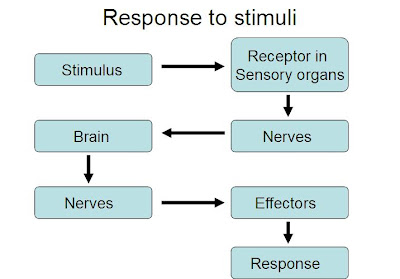1.2 Sense of Touch
1. Skin is the sensory organ that can detect touch, pain, pressure, heat and cold
2. Consists of 3 main layer:
a) epidermis – outer layer
b) dermis – inner layer
c) fatty layer - insulator
3. Structure of human skin
4. Function of different receptors:
a) pain receptors - detect painb) touch receptors - detect light touches
c) heat receptors - detect heat
d) cold receptors - detect cold
e) pressure receptors - detect pressure
1.3 Sense of Smell
1. Nose is the sensory organ for smell that can detect chemicals in the air.
2. Smell receptors located at the top of nasal cavity.
3. The nasal cavity lined with mucous that is important to dissolve chemicals
4. Structure of human nose.
5. Detection of smells
=> Chemicals in the air enter the nasal cavity, dissolved in in the mucus to stimulate smell receptors.
=> Smell receptord produce impulse and send the messages to the brain.
=> Brain interprets the messages
=> Smell identified
1.4 Sense of Taste
1. The tongue is sensory organ related to the sense of taste
2. 4 basics taste: sweet, salty, sour and bitter
3. The surface of tongue covered with taste buds.
4. Each taste bud contains many taste receptors.
5. Saliva dissolve chemicals to be detect by taste receptors
6. Sense of taste is helped by sense of smell
1.5 Sense of Hearing
1. Ears are the sensory organs of hearing that can detect sound.
2. Human ears has 3 main parts:
a) Outer ear; pinna, ear canal, eardrum
b) Middle ear; ossicles (hammer, anvil & stirrup), oval window and Eustachian tube.
c) Inner ear; cochlea, auditory nerve and semicircular canals.

1.6 Sense of Sight
1. Sensory organs for sight are the eyes, which sensitive to light.

2. The wall of the eyeball is made up of 3 layers:
a) Sclera – tough, outer layer
b) Choroid – black, middle layer
c) Retina – sensitive to light, innermost layer













0 comments:
Post a Comment